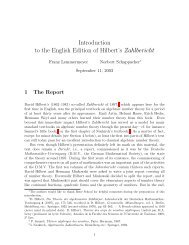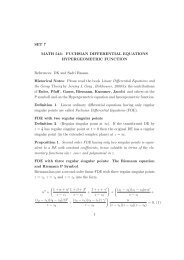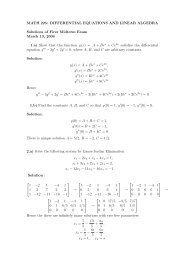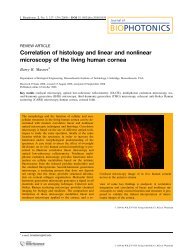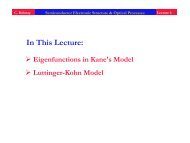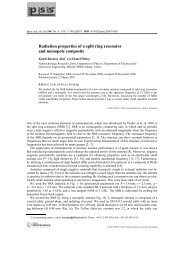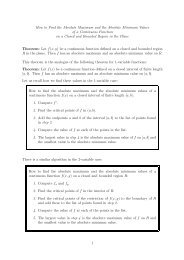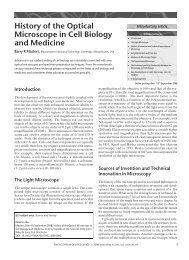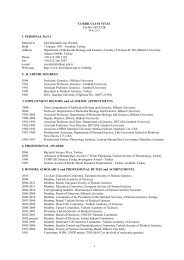Create successful ePaper yourself
Turn your PDF publications into a flip-book with our unique Google optimized e-Paper software.
7.3 <strong>The</strong> Order <strong>of</strong> Residue Classes<br />
Assume that we are given an integer m and an integer a coprime to m. <strong>The</strong><br />
smallest exponent n > 0 such that a n ≡ 1 mod m is called the order <strong>of</strong> a mod m;<br />
we write n = ord m (a). Note that we always have ord m (1) = 1. Here’s a table<br />
for the orders <strong>of</strong> elements in (Z/7Z) × :<br />
a mod 7 1 2 3 4 5 6<br />
ord 7 (a) 1 3 6 3 6 2<br />
If m = p is prime, then <strong>Fermat</strong>’s Little <strong>The</strong>orem gives us a p−1 ≡ 1 mod p,<br />
i.e., the order <strong>of</strong> a mod p is at most p − 1. In general, the order <strong>of</strong> a is not p − 1;<br />
it is, however, always a divisor <strong>of</strong> p − 1 (as the table above suggested):<br />
Proposition 7.4. Given a prime p and an integer a coprime to p, let n denote<br />
the order <strong>of</strong> a modulo p. If m is any integer such that a m ≡ 1 mod p, then<br />
n | m. In particular, n divides p − 1.<br />
Pro<strong>of</strong>. Write d = gcd(n, m) and d = nx + my; then a d = a nx+my ≡ 1 mod p<br />
since a n ≡ a m ≡ 1 mod p. <strong>The</strong> minimality <strong>of</strong> n implies that n ≤ d, but then<br />
d | n shows that we must have d = n, hence n | m.<br />
Here comes a pretty application to prime divisors <strong>of</strong> Mersenne and <strong>Fermat</strong><br />
numbers.<br />
Corollary 7.5. If p is an odd prime and if q | M p , then q ≡ 1 mod 2p.<br />
Pro<strong>of</strong>. It suffices to prove this for prime values <strong>of</strong> q (why?). So assume that<br />
q | 2 p − 1; then 2 p ≡ 1 mod q. By Proposition 7.4, the order <strong>of</strong> 2 mod p divides<br />
p, and since p is prime, we find that p = ord p (a).<br />
On the other hand, we also have 2 q−1 ≡ 1 mod p by <strong>Fermat</strong>’s little theorem,<br />
so Proposition 7.4 gives p | (q − 1), and this proves the claim because we clearly<br />
have q ≡ 1 mod 2.<br />
Example: M 11 = 2047 = 23 · 89.<br />
<strong>Fermat</strong> numbers are integers F n = 2 2n + 1 (thus F 1 = 5, F 2 = 17, F 3 = 257,<br />
F 4 = 65537, . . . ), and <strong>Fermat</strong> conjectured (and once even seemed to claim he<br />
had a pro<strong>of</strong>) that these integers are all primes. <strong>The</strong>se integers became much<br />
more interesting when Gauss succeeded in proving that a regular p-gon, p an<br />
odd prime, can be constructed with ruler and compass if p is a <strong>Fermat</strong> prime.<br />
Gauss also stated that he had proved the converse, namely that if a regular<br />
p-gon can be constructed by ruler and compass, then p is a <strong>Fermat</strong> prime, but<br />
the first (almost) complete pro<strong>of</strong> was given by Pièrre Wantzel. 1<br />
Corollary 7.6. If q divides F n , then q ≡ 1 mod 2 n+1 .<br />
1 Pièrre Wantzel, 1814 (Paris) – 1848 (Paris).<br />
71




